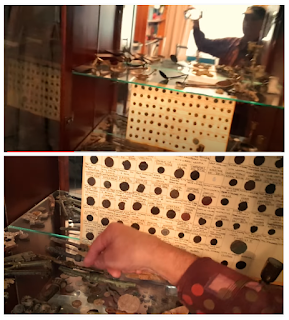9.3: Curation - Documentation of Artefact Collections
 |
| Totally unlabelled jumble of objects of all periods displayed by a Gloucestershire detectorist (Detecting for Gold 1 Jan 2019) |
As outlined by Ambourouè Avaro (2010, 2) in a manual of collection documentation:
When an object is moved from its place of origin and its context, its significance is reduced and becomes more reliant on the documentation linked to it. Furthermore, when an object arrives [in a collection], it begins a “new life”: it will be studied, positioned, exhibited, restored, loaned and transferred, and will be placed alongside many other objects. It will thus be necessary to identify it in a unique way, and to facilitate the management of every aspect of this new life. The value of a collection (whether it be for purposes of research, education or interpretation), its safety and its accessibility therefore depend to a large extent on the quality of the documentation associated with it. Documentation is thus the organization of information. Basic documentation is needed for the “administrative” management of collection. It enables the [collection] quickly and effectively to:This basic documentation can be supplemented by other elements if so desired.
• establish proof of ownership
• locate a specific object
• find out the total number of objects making up the collection
• carry out an inventory
• establish the (always unique) identity of an object
• link information to an object
• access information in an efficient and economical way (saving space, time or effort)
• contribute to the safety of collection
• carry out an insurance valuation [...]
• have a record of the acts of conservation/restoration which the objects have undergone
• plan preventive conservation, organization of stores, etc.
A museum’s documentation system is a set of elements (Accession number, Accession register, manual or computerised files, etc.) that are related to each other and to the collection of which they form a part. In the case of material gained from artefact hunting, the documentation will include information on the context and location of its discovery (items added by purchase should have their origins and past collecting history fully documented).
Among the 'Standards for documentation' (Standards Standards-in-the-museum-care-of-archaeological-collections.pdf p. 25, chapter 6), the following seem most applicable here:
6.1 Entry records must be maintained of all items deposited in the [collection] [...] 6.2 Bound registers must be maintained with records about all accessions, each including an accession or inventory number and sufficient information for collection management purposes. [...] Fully automated accession systems must be backed up by a bound hard-copy record on archival-quality paper.Records, including paper, electronic media etc must be kept to the standards set out in the several guidelines prepared for museum use. As far as possible records forming part of the Primary Records from field investigations should be duplicated so that a second copy can be stored in a secure, but separate location to prevent loss or damage. The collector should aim to maintain all records to the standard set out in BS 4971:2017. A copy of all archaeological records should be deposited in (and in the form agreed by) the relevant archaeological database for the region.
6.3 Each accession and (where appropriate) each individual item must be marked or labelled with an unique accession or inventory number. Such marking must not damage the object. Any previous marking must be preserved or recorded.
6.4 A catalogue must normally be maintained, bringing together all the primary information about each item or group in the collection.
6.5 One or more indexes, or equivalent information retrieval facilities, must be maintained [...]
6.6 Back-up copies of key records, including entry records, accession records, catalogue records and current exit records must be made regularly and kept in a separate building.
6.7 The documentation system must record every movement of an object both inside and in and out of the [collection].
6.8 Every new acquisition must be accessioned as soon as possible [...], and the [collection] must adopt a formal policy designed to address any backlog of documentation.
The organisation of the documentation should allow access to all the information on individual objects to be easily retrieved and also information on each site/search area to be kept together.
A carefully-conceived policy needs to be developed from the outset how it is proposed to deposit a copy of the final form of the archive (to maintain its integrity) as well as allow the splitting off of the documentation of individual artefacts to accompany each of them when the collection is eventually split up and passed on to another generation of collectors.
The Collections Trust determines standards for museum documentation, publishes appropriate guidance, record cards and computer programs, and offers general advice on all aspects of documentation.
Bibliography:
See also: Statement of principles of museum documentation CIDOC Documentation Standards Working Group 6 June 2012
Holm, Stuart A. 1998, Facts and Artefacts: How to Document a Museum Collection (Second edition), Museum Documentation Association/Collections Trust, Cambridge.
Anne Ambourouè Avaro 2010, 'Documentation of Museum Collections, why? How? Practical guide , UNESCO, ICCROM and EPA
BS 4971:2017 Conservation and care of archive and library collections
 Tamara Kroftova comments:
Tamara Kroftova comments:"Possibly the idea of a home museum appeals to a number of collectors, but the private curation of elements of the archaeological record, if it is not merely to be a wasteful and destructive trashing of the archaeological record cannot be a group of loose artefacts arranged in a hobbyist's glass case, but needs to be curated to the same high standards as a public collection like a museum. In particular this concerns the care taken over the protection and documentation of the collected items. To be satisfied with anything less is the sort of irresponsible amateurishness that brings such collectors into disrepute."



Comments
Post a Comment